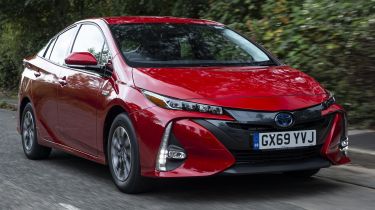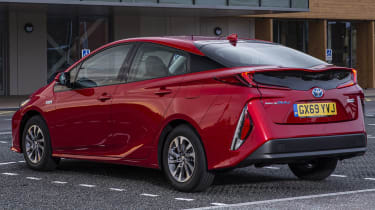Toyota Prius Plug-In (2016-2022) review
The Prius Plug-In is very efficient, good to drive and comfortable - but not as convincing as the regular version of the car

Pros
- Low running costs
- Incredible efficiency
- Refinement and comfort
Cons
- Small boot
- Infotainment
- Regular hybrid better value
| Car type | Electric range | Fuel economy | CO2 emissions |
|---|---|---|---|
| Plug-in hybrid | 34 miles | 188-217mpg | 28g/km |
The Toyota Prius is a huge name in the world of hybrids, but there’s also this plug-in model to consider. It's very similar to the regular hybrid, but has a plug socket that allows you to charge the battery from a wallbox for around 30 miles of pure-electric range. It’s a direct rival to the Hyundai Ioniq Plug-In, although neither car is available new in the UK as of mid-2022.
There are other rivals, too, including SUVs such as the Kia Niro PHEV. Yet the Prius is more specialised than the Kia, as the bodywork is designed to be as aerodynamic as possible, making the best possible use of an efficient petrol engine, a small electric motor and a battery.
It features a 97bhp 1.8-litre petrol engine and what Toyota calls a 'Dual Motor Drive' system. The total power output is 120bhp, which isn’t huge, but the electric motor means that it gets off the line swiftly enough and 0-62mph takes 11.1 seconds.
The Prius is a little less powerful than its rival the Ioniq Plug-In, but it doesn’t need to bring top performance as it’s clearly designed for efficiency. There’s a good amount of driving range on electric power alone and unlike in the regular hybrid, you can stay in electric mode at any legal speed in the UK.
There are different driving modes including Eco and even a Power mode, which makes the engine and motor setup even more responsive to accelerator inputs. You'll notice the benefits of the Dual Motor Drive system as the Prius Plug-In feels eager enough around town, accelerating off the line with plenty of power and making swift and near-silent progress.
Sophisticated suspension means there’s ride quality to match, too. The setup takes bumps in its stride and feels soft and compliant most of the time, whether that’s in town or at higher speeds, yet it’s also surprisingly good to drive. The Prius delivers decent agility and relatively composed handling for an eco-friendly car, even if the steering has next to no feel.
The CVT automatic gearbox actually helps refinement as long as you don’t accelerate too hard. The assistance from the Dual Motor setup means the engine doesn’t have to rev too hard so long as you don’t press the accelerator flat to the floor – if you do things do get a bit noisy as the CVT gearbox holds the revs high for maximum acceleration.
The system recoups energy when braking, too, so you can top up on the move. Plug in overnight and you can fully charge the 8.8kWh battery pack in just under four hours using a domestic socket. This drops to around two-and-a-half hours with a wallbox charger that makes the most of the car’s 3.3kW charging.
It’s all fairly positive for the Prius Plug-In, then. A refresh in 2019 upgraded the rear bench to three seats – at launch, there were only two seats in the back, which limited practicality. However, there’s still only 191 litres of boot space with the rear seats in place, owing to a bigger battery pack compared to the regular Prius.
The infotainment is lacking, too, and some of the materials feel cheap, even if build quality is good – but focus on the claimed economy of 217mpg and you’ll be reminded that this is a very cheap car to run, yet there’s a good level of kit, even if, with only two trims to choose from, the range isn’t the most expansive.
So the Prius Plug-In isn’t without merit and it’s a worthy eco-friendly car that you should consider if you’re after an affordable secondhand plug-in hybrid. For a more detailed look at the Toyota Prius Plug-In, read on for the rest of our in-depth review...




